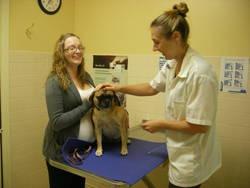
Sore joints, difficulty going up stairs and pain… these are just a few of the clues that might suggest that your dog could be experiencing arthritis.
The term arthritis (also known as osteoarthritis or degenerative joint disease) means inflammation of the joint or several joints. It is caused by the breakdown of cartilage in the joints. Cartilage is required to provide a cushion between moving bone ends. Without shock absorption, the bone ends change shape in an attempt to preserve the dog’s ability to move. This phenomenon is chronically painful and never as effective as a healthy joint.
How did my dog get arthritis?
- Previous damage to a joint (torn ligaments, fractures or disease)
- Congenital joint disease – examples include hip dysplasia and medial luxating patella
- Obesity – which causes abnormal forces on joints
- Sedentary lifestyle – routine movement is needed to lubricate the joints
- Old age – daily wear and tear
How do I know if my dog has arthritis?
While watching your dog every day, it may be hard to detect gradual changes, but the most common phrase that we get from clients is that their dog is “slowing down”. Some signs include:
- A change in posture – subtle weight shifting off of the front limbs and on to the back limbs
- Stiffness – shorter strides while walking or difficulty moving its head in one direction
- Crankiness – especially when a sore part of its body is handled
- Muscle loss
- Hesitation or inability to use stairs
- Hesitation or inability to jump up into the car or on to furniture
- Difficulty getting comfortable – difficulty going from a laying down position to standing
- Limping or lameness, especially in the morning
- Decreased activity level and less desire to play
How is arthritis diagnosed?
Arthritis is often diagnosed by a combination of symptoms observed by a veterinarian – a physical examination of the dog’s limbs, joints and spine and watching the dog walk. X-rays are a valuable tool to assess for boney changes around joints, confirming arthritis.
How is arthritis in dogs treated?
As mentioned in our blog article about arthritis in cats, there are a number of options available to treat the symptoms of pain, as well as to slow the progression of this disease. Stay tuned for our upcoming blog on arthritis therapies for cats and dogs. Arthritis is a disease where each patient may respond differently to the variety of management options available.
If you have any questions or concerns about arthritis and your dog, give our team at Coventry Animal Hospital a call.

